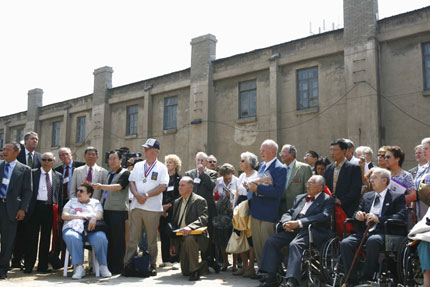POWs remember life in Japanese prison camp
(Reuters)Updated: 2007-05-26 17:42
Now, nine American veterans have returned to the site of the prisoner-of-war camp where they were held by Japanese forces during World War Two, to commemorate China's decision to turn the cluster of brick buildings into a museum.
"Well, you know, it's nice to come back and see where you have been but the sad part about it is you don't like to remember," said Ralph Griffith.
For three years, Griffith, who can still recite his roll call in Japanese, spent three years better known by his camp number, 552.
Griffith was one of more than 2,000 prisoners from the United States, Britain, the Netherlands and Australia imprisoned at the camp in Shenyang, the Manchurian city formerly known as Mukden, between November 1942 and August 1945.
The veterans have contributed their own personal artifacts to a display at the museum, which will comprise the camp's original two-storey brick building, bungalows and water tower.
Two walls will be inscribed with the names of the inmates, whose photographs, uniforms and dog tags will be registered and added to the museum's exhibit.
The American troops went through several ordeals before ending up at the Mukden Allied POW camp.
After surrendering to the Japanese in the Philippines, they were forced through the Bataan Death March, in which tens of thousands of emaciated soldiers, many sick with malaria, were made to march for days in the tropical heat.
The old soldiers, now graying and bespectacled, also survived the Japanese Hell Ships, in which prisoners were crammed into the stifling hulls of unmarked transport ships, which were then unwittingly bombed by allied war planes.
Once at the camp, life was hardly better.
Sleeping quarters consisted of rough wooden slats, where prisoners slept eight to a shelf.
Wayne Miller remembers how the desperate prisoners resorted to any means to find a source of protein to supplement their diet -- usually two bowls of rice a day, with little meat or vegetables.
"We couldn't eat the food so some of the fellas took these ropes, made a loop out of them," Miller explained.
"The other end went to a door, so they took the food and put it in the loop and the dogs came along and they pulled on the other end, caught the dogs under the collar, in the neck, most of the time and they pulled them to the door and beat them to death and then that meat was eaten," he said.
All had vivid memories of the bitter winter cold, and nursing the small rations of coal they were given to feed the stoves.
Few managed to escape, and the price for being recaptured was their lives.
"They were caught and they were brought back to our camp and dug their graves," said Miller, from Mertztown, Pennsylvania.
"Then they made all of us in the camp get out and stand there and watch them being shot and then they were buried right there," he said, becoming choked up at the memory and pausing to compose himself.
Once Shenyang was liberated the roles of prisoner and captor were reversed.
The Japanese guards were incarcerated and the newly freed allied soldiers suddenly found themselves armed with guns and ordered to guard the compound.
Hal Leith, a U.S. paratrooper in 1945, got to tell the POWs about Japan's surrender.
"They had a million questions," said Leith, who like Griffith and Miller is now in his 80s. "They wanted to know if Shirley Temple was still alive."
|
||
|
||
|
|

